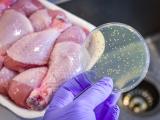Apr 11, 2008 (CIDRAP News) – The US Department of Agriculture (USDA) held a 2-day meeting this week to gather feedback on its next proposed steps to reverse the recent increase in recalls and illnesses related to Escherichia coli O157:H7 in ground beef.
The meeting, held in Washington, DC, featured status reports on some of the actions the USDA announced in October to address the increase in ground beef recalls, such as using a new checklist to determine if suppliers and processors are taking the right steps to control E coli contamination.
USDA officials also fleshed out the rationale for two new proposals the agency is considering: defining E coli O157:H7 as an adulterant in primal cuts of beef and exploring if the agency's Food Safety and Inspection Service (FSIS) should regulate non-O157 Shiga toxin–producing E coli (STEC) in beef products.
In opening statements Apr 9, Richard Raymond, the USDA's under secretary for food safety, said that 10 of 21 ground beef recalls in 2007 had associated illnesses.
"I don't think anyone has become complacent in the last year or two. What may have changed is the ecology of the bug, or the prevalence of the bug, or the concentrations of the bug on hide or in the gut of the herd," Raymond said. "And until we do [know what led to the increase in recalls],so we can attack the problem at the preharvest stage, we just do everything possible to reverse the trends and protect public health."
The changes announced last fall were good and relatively noncontroversial, he said, "but now we need bolder, stronger initiatives."
Update on previous actions
Christopher Alvares, a data analyst for the FSIS, presented preliminary results from a systematic HACCP (hazard analysis/critical control point) reevaluation of meat producers and processors, which includes a checklist that he said provides a snapshot of each firm's operations.
He said 52% of firms have made one or more changes to their processes during the checklist assessments and that the firms that had recalls had implemented fewer changes, which perhaps suggests that they had previously made post-recall changes.
"These are initial findings and we need to investigate them further," he said, adding that the FSIS hopes to issue a final analysis in July.
Officials explain adulterant rationale
Regarding the USDA's proposal to consider E coli O157:H7 an adulterant in primal cuts of beef—those that are intact and thought to have a sterile interior—officials said they were concerned about cross-contamination during meat preparation. Daniel Engeljohn, deputy assistant in the FSIS Office of Policy and Program development, said some primal cuts are being made into ground beef, and some of them may not have received an antimicrobial treatment that is typically applied to boneless trim.
"In the long-term, we have to look back upstream. We have to force controls upstream as far as possible," Engeljohn said. "We haven't made any decisions, but what we have now hasn't worked."
Federal officials have also been exploring food safety controls in imported ground beef. Sally White, who directs the FSIS's international equivalency staff, said of nine countries that export ground beef to the United States, the agency has so far verified that Australia, Costa Rica, New Zealand, and Uruguay have testing protocols that meet or exceed US controls. She said the agency is still evaluating the ground beef safety systems used by Canada, Chile, Honduras, Nicaragua, and Mexico.
Why test for non-O157 STEC?
In a session on the USDA's plan to conduct a short-term study of non-O157 STEC in ground beef and its components, Elisabeth Hagen, executive associate for public health in the FSIS's Office of Public Health Science, said though the agency doesn't currently have a protocol to test for the organisms, illness reports involving different serogroups are increasing.
"It you look for them, you will find them," Hagen said, adding that the US Centers for Disease Control (CDC) lists six non-O157 STEC strains that are pathogenic to humans: O26, O111, O103, O121, O45, and O145.
Studies in some states, such as Virginia and Idaho, that are not part of the CDC's FoodNet surveillance system have shown that the prevalence of non-O157 STEC isolates is greater than or equal to that of E coli O157:H7.
Hagen said that of 23 non-O157 STEC outbreaks since 1990, none involved meat, though cattle are the primary animal reservoir for the organisms.
Industry groups oppose new regulations
Representatives from some of the major meat industry trade groups oppose the USDA's proposals to consider E coli as an adulterant in primal beef and begin testing for non-O157 STEC. Dean Danielson, vice president for food safety at Tyson Foods Inc., presented a statement from the Beef Industry Food Safety Council (BIFSCo) that was signed by 18 other firms.
He said there is no scientific evidence that E coli O157:H7 is a common contaminant on intact primal beef and that current industry best practices are adequate for controlling the pathogen in the products.
BIFSCo also opposes declaring non-O157 STEC as adulterants, he said, because the CDC has not linked the organisms to any beef-related outbreaks.
In a statement e-mailed to CIDRAP News, BIFSCo said, "The best course of action is for industry and government to continue targeting E coli O157:H7 with validated interventions and appropriate testing since this is the subgroup that is most virulent and most often associated with severe human disease. Broad spectrum interventions currently in place will have a correlated effect on other serogroups beyond O157."
The group advised the USDA to allow enhanced safety systems, stipulated in its October 2007 safety recommendations, time to take effect before pushing for regulatory changes.
Randall Huffman, vice president of scientific affairs for the American Meat Institute, also echoed industry opposition to the USDA's adulterant and non-O157 STEC proposals. "We recognize that we have to redouble our efforts," he said.
In an Apr 9 statement e-mailed to CIDRAP News, AMI President James Hodges said expanding the E coli O157:H7 adulterant policy to primal cuts would not solve the problem with ground beef contamination.
"No policy change by government can alter the current scientific reality that bacteria exist on all fresh agricultural products," he said in the statement. "The data tells us, however, that Americans enjoy beef products safely better than 99.99% of the time. Let's not lose sight of that as we contemplate the food safety changes at hand."
Consumer groups weigh in
Consumer groups such as Food and Water Watch and Safe Tables Our Priority (STOP) attended the sessions. Donna Rosenbaum, executive director of STOP, said the USDA's proposals were a step in the right direction.
"Cross-contamination is a huge issue. We shouldn't have this burden as much as we do—we need intervention at the source," she said.
Rosenbaum and other participants suggested that federal agencies need to collaborate more to prevent ground beef contamination, particularly on issues related to the preslaughter exposure of cattle to the pathogen.
See also:
Mar 28 CIDRAP News story "USDA sets meeting to air next steps on E coli"
Oct 23, 2007, CIDRAP News story "USDA announces plans to reduce E coli contamination in ground beef"
Apr 9 remarks by USDA undersecretary for food safety Richard Raymond
Apr 10 CIDRAP News story "Foodborne disease rates changed little in 2007"
















